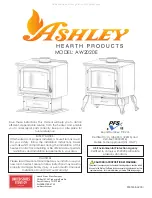
-13-
RELOADING
Once you have obtained a good bed of embers, you should reload the unit. To do so, open the air controls to
maximum a few seconds before opening the stove’s door. Then proceed by opening the door very slowly; open
it one or two inches for 5 to 10 seconds, before opening it completely to increase the draft and thus eliminate
the smoke which is stagnant in a state of slow combustion in the stove. Then bring the red embers to the front of
the stove and reload the unit. For optimal operation of your wood stove, we recommend you to operate it with
a wood load approximately equivalent to the height of fire bricks. It is important to note that wood combustion
consumes ambient oxygen in the room. In the case of negative pressure, it is a good idea to allow fresh air in the
room, either by opening a window slightly or by installing a fresh air intake system on an outside wall.
CREOSOTE FORMATION AND NEED FOR REMOVAL
When wood is burned slowly, it produces tar and other organic vapors, which combine with expelled moisture to
form creosote. The creosote vapors condense in the relatively cool chimney flue of a slow-burning fire. As a result,
creosote residue accumulates on the flue lining. When ignited this creosote makes an extremely high temper fire.
The chimney connector and chimney should be inspected at least once every two months during the heating
season to determine if a creosote build-up has occurred. If creosote has accumulated (3 mm or more), it should
be removed to reduce the risk of a chimney fire.
We strongly recommend that you install a magnetic thermometer on your smoke exhaust pipe, approximately
18” above the stove. This thermometer will indicate the temperature of your gas exhaust fumes within the smoke
exhaust system. The ideal temperature for these gases is somewhere between 275°F and 500°F. Below these
temperatures, the build-up of creosote is promoted. Above 500°F, heat is wasted since a too large quantity is lost
into the atmosphere.
TO PREVENT CREOSOTE BUILD UP
•
Always burn dry wood. This allows clean burns and higher chimney temperatures, therefore less creosote
deposit.
•
Leave the air control fully open for about 5 min. every time you reload the stove to bring it back to proper
operating temperatures. The secondary combustion can only take place if the firebox is hot enough.
•
Always check for creosote deposit once every two months and have your chimney cleaned at least once a
year.
If a chimney or creosote fire occurs, close all dampers immediately. Wait for the fire to go out and the heater
to cool, then inspect the chimney for damage. If no damage results, perform a chimney cleaning to ensure no
more creosote deposits is remaining in the chimney.
ASH DISPOSAL
Whenever ashes get 3 to 4 inches deep in your firebox or ash pan, and when the fire has burned down and cooled,
remove excess ashes. Leave an ash bed approximately 1 inch deep on the firebox bottom to help maintain a hot
charcoal bed. Ashes should be placed in a metal container with a tight-fitting lid. The closed container of ashes
should be placed on a non-combustible floor or the ground, away from all combustible materials, pending final
disposal. The ashes should be retained in the closed container until all cinders have thoroughly cooled.
CAUTIONS:
•
ASHES COULD CONTAIN HOT EMBERS EVEN AFTER TWO DAYS WITHOUT OPERATING THE STOVE.
•
THE ASH PAN CAN BECOME VERY HOT. WEAR GLOVES TO PREVENT INJURY.
•
NEVER BURN THE STOVE WITH THE ASH TRAP OPEN. THIS WOULD RESULT IN OVER FIRING THE STOVE. DAMAGE
TO THE STOVE AND EVEN HOUSE FIRE MAY RESULT.
ATTENTION:
This wood heater needs periodic inspection and repair for proper operation. It is against federal regulations
to operate this wood heater in a manner inconsistent with operating instructions in this manual.
All manuals and user guides at all-guides.com














































